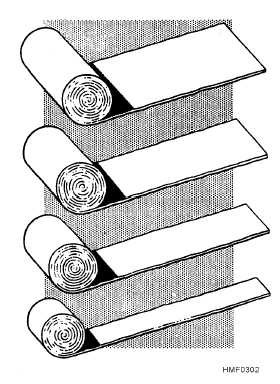other. Bandages should be applied evenly, firmly, but
not too tightly.
Excessive pressure may cause
interference with the circulation and may lead to
disastrous consequences. In bandaging an extremity, it
is advisable to leave the fingers or toes exposed so the
circulation of these parts may be readily observed. It is
likewise safer to apply a large number of turns of a
bandage, rather than to depend upon a few turns
applied too firmly to secure a compress.
In applying a wet bandage, or one that may become
wet, you must allow for shrinkage. The turns of a
bandage should completely cover the skin, as any
uncovered areas of skin may become pinched between
the turns, with resulting discomfort. In bandaging any
extremity, it is advisable to include the whole member
(arm or leg, excepting the fingers or toes) so that
uniform pressure may be maintained throughout. It is
also desirable in bandaging a limb that the part is
placed in the position it will occupy when the dressing
is finally completed, as variations in the flexion and
extension of the part will cause changes in the pressure
of certain parts of the bandage.
The initial turns of a bandage on an extremity
(including spica bandages of the hip and shoulder)
should be applied securely, and, when possible, around
the part of the limb that has the smallest circumference.
Thus, in bandaging the arm or hand, the initial turns are
usually applied around the wrist, and in bandaging the
leg or foot, the initial turns are applied immediately
above the ankle.
The final turns of a completed bandage are usually
secured in the same manner as the initial turns, by
employing two or more overlying circular turns. As
both edges of the final circular turns are exposed, they
should be folded under to present a neat, cufflike
appearance.
The terminal end of the completed
bandage is turned under and secured to the final turns
by either a safety pin or adhesive tape. When these are
not available, the end of the bandage may be split
lengthwise for several inches, and the two resulting
tails may be secured around the part by tying.
ROLLER BANDAGE FOR ELBOW.—A spica
or figure-eight type of bandage is used around the
elbow joint to retain a compress in the elbow region
and to allow a certain amount of movement. Flex the
elbow slightly (if you can do so without causing further
pain or injury), or anchor a 2- or 3-inch bandage above
the elbow and encircle the forearm below the elbow
with a circular turn. Continue the bandage upward
across the hollow of the elbow to the starting point.
Make another circular turn around the upper arm, carry
it downward, repeating the figure-eight procedure, and
gradually ascend the arm. Overlap each previous turn
about two-thirds of the width of the bandage. Secure
the bandage with two circular turns above the elbow,
and tie. To secure a dressing on the tip of the elbow,
reverse the procedure and cross the bandage in the back
(fig. 3–4).
3-4
Figure 3–2.—Roller bandages.
Figure 3–3.—Applying a roller bandage.




